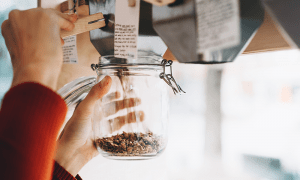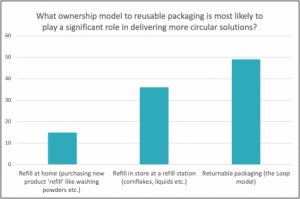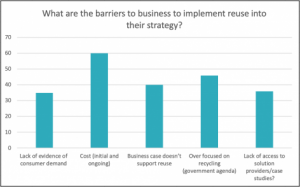Reuse: new ways of managing resources and reducing waste
14th May 2020
This blog was originally published on CIWMs Circular Online on 12 May 2020.
Dr. Adam Read, External Affairs Director at SUEZ recycling and recovery UK, and Helen Chaplin, Technical Development Executive at CIWM explore the issues discussed in the recent CIWM webinar about reuse.
With the UK using 1.2 billion tonnes of materials a year, the equivalent of 18.5 tonnes per person, the need for a circular economy has never been more apparent. Despite this, many of the products and packaging currently available to consumers are designed to be replaced or are made in such a way that limits our ability to extend their life through repair, refill or refurbishment.
A key element of the ongoing war on waste is prevention, and reuse plays an unfulfilled yet vital role in this. The redistribution of furniture, tools, books, CDs, DVDs, toys and games to new owners, without reprocessing into different physical forms, is well established in the UK. These items are redistributed through household waste recycling centres (HWRCs) and high street charity shops, but the opportunity is much wider than bric-a-brac, clothes and furniture.
For all the effort and attention given to reuse in recent years, it still isn’t a central pillar of government policy, local authority service provision or, more importantly, modern culture. So what needs to change and how can the EU’s Circular Economy Action Plan, the new EU Eco Design Directive, and DEFRA’s Resources and Waste Strategy help in repositioning reuse within society?

Changing perceptions related to reuse is perhaps one of the most important challenges to overcome. Second-hand items are often seen as being lower quality, or only for those who can’t afford to buy new. Though some innovative services are starting to make waves, even before their official launch in the UK. One example is Loop, which deliver premium branded products to consumers in reusable packaging, which is then collected, cleaned and used again. Are these models the future of our packaging and shopping experiences? That was the intention of the first webinar (hosted live on the 06 May 2020) of a planned series of joint webinars by CIWM and SUEZ and chaired by CIWM’s Senior Vice President and SUEZ’s External Affairs Director, Dr. Adam Read.
Over the course of the hour our panellists Steve Clarke (TerraCycle UK), Sarah Greenwood (Grantham Centre for Sustainable Futures) and Tracy Sutton (Root) debated a range of issues about new reuse opportunities and the barriers to their uptake. Together with lots of questions raised by the delegates and the experiences and insights of the panel we built up a vision of reuse. We investigated some of the challenges to implementing reuse and reflected on what needs to happen next to build momentum around reusable, refillable and returnable packaging in particular.
Taking questions from the audience, and the poll results, the webinar highlighted several key points:
Reuse isn’t given the policy platform needed by current resources and waste management strategies in the UK
By asking the audience, we wanted to assess if they felt that reuse was a central pillar of current government resource policy. Our poll results showed that 82% of those who voted, don’t think that reuse is given the policy platform needed by current resources and waste management strategies in the UK. The panellists agreed, and had been expecting a similar level of negativity, stating that reuse in recent years had been paid little more than lip service, whilst emphasis was placed much more on weight based KPIs and thus recycling.
Reuse needs (re)defining
It became obvious early into the webinar, that we need to clearly define what reuse is. The general public consider reuse as reusing items, however, Sarah pointed out that this isn’t part of a packaging waste management system and also that it’s not defined as packaging reuse within the relevant regulations. As such, this area of activity wouldn’t be actively promoted.
Furthermore, Tracy suggested we need to be clearer on the definitions of packaging. As it’s an incredibly muddy area, it’s not surprising the policy and strategies that surround it are equally vague.
Sarah suggested different definitions are required for different applications because packaging is a high-volume material flow compared to for example, electronic items. Items need to be managed in slightly different ways and the panellists agreed with this.
Additionally, Tracy believed that we need to clearly define how and where reuse and refill is integrated into a product strategy or a packaging strategy and into society as a whole, if we’re to slow down climate change and drive down resource consumption.
As such, the webinar started to focus its debate more on packaging reuse options and opportunities, showing how the feedback we receive live can shape the discussions.
We need to think hard about how we implement and transition towards the circular economy
Tracy highlighted that we need to reconsider how the circular economy is implemented here in the UK and further afield, as it’s currently done in a similar way to the disposable or linear model. Steve stated that we know that recycling on its own is not enough to get us out of the situation we’re in, in terms of resource extraction and climate change. We have to change the way we consume as a society and that’s where reuse platforms like Loop can make a difference. Furthermore, our problems can’t be solved by technology alone, we must fully embrace behaviour change. There can be lessons learned from the adaptability and resilience of the public to change during the COVID-19 pandemic, to see how we can make the environment and its protection central to consumer decisions and lifestyles going forward.
The consumer wants convenience and choice
It was clear in the second and third audience polls, that convenience was a key concern to any real progress being made on reuse. Each of the options had been introduced by the panel earlier on in the webinar, and now we could see how the audience felt about their deliverability.

Steve justified the results of the second poll, stating that the key feature which the consumer wants in a reuse-based platform is convenience and choice. They would like all the benefits of disposability in a reuse service, to get enough people to embrace the change, so offering them home delivery (or in store if they prefer) of mainstream brands is the way to reach consumers.
The third poll allowed two responses to be selected, and the most common concerns raised for public engagement with reuse platforms today were a lack of time/convenience and availability of the reuse solutions. Sarah elaborated that convenience is key, and if it is not convenient for consumers, then they’re not going to want to do it. If it isn’t convenient, then other incentives are needed to drive the desired changes in attitude and behaviour, and they aren’t forthcoming right now. Steve continued by stating, that the awareness of the service can be a real issue, because if nobody knows it exists then it will be underutilised.
There are issues around scaling up current reuse models
When considering the range of different reuse models, and why they haven’t been scaled up in many examples, it was suggested by the panel that recycling and recovery have had a lot more emphasis (from both government and consumer) than reuse. This is despite reuse models being embedded in packaging regulations since 1994 and being at the upper tiers of the waste hierarchy for just as long. It was also suggested that there is a lot of easy money and easy sales in disposability and as such there has been little incentive for businesses (brands and retailers) to consider reuse in a mainstream way. However, with a revised Extended Producer Responsibility framework due in Europe and in the UK in the coming years, this might be the opportunity to better incentivise design that favours refillable and reusable packaging, through appropriate fees, taxes or subsidies.
Another issue to consider when scaling up any reuse model, was concern that there remains some uncertainty and confusion about whether it’s a product or it’s just packaging which again points to the issues surrounding the definition of reuse. The other reason that Tracy touched upon was the lack of research into how the “pilot” models would work when scaled up and the lack of convincing evidence for a company to seek investment in new solutions that might be considered ‘disruptive’. After all, how many customers will actually reuse rather than those that just say they will?
How do you collect data on reuse models and measure their performance?
It became clear during the webinar, that data is what everyone wants and needs. However, it was suggested by Steve that businesses have to share the data that others need in order for them to learn. However, as systems are still evolving, they aren’t always willing to do this. With data across lots of platforms, including apps such as Freegle and Freecycle, how can we understand the scale of what’s already happening, and then predict what might happen?
One option is to head towards a system that captures reuse, repair, refurbishing and recycling of items in the data, alongside recycling, composting and energy recovery tonnage. The way we interpret the data and make it comparable is perhaps more important for long term change.
Tracy also stated that it’s one thing to obtain the data, but it’s more important to be able to translate the data into something the customer understands. It’s important to make the consumer feel good and incentivise them to get involved again, by indicating for instance the carbon savings from refill or repair over buying new.
Our current systems are all based on weight, and on recycled proportions, so how do we track and trace the usage and therefore the improved performance of reusable goods? Sarah suggested that you could look at weight saved of all resources not just physical but energy as well, such as carbon dioxide emissions. There was widespread support for personal carbon allowances going forward.
Perhaps we need new standards (performance specifications) for something that’s reusable, like a kite mark, certifying, for example, that an item must be able to be reused 20 times. This could help stop poor design and businesses capitalising on the reuse revolution. We also need to find a new way to measure the reuse economy, the panel had contrasting views on whether life cycle assessments are really the right measurement tool.
We need to help facilitate consumers behaviour towards reuse
Sarah stated that “you’ve got to lead the consumers by the hand, and consumers are quite unadventurous”. Consumers will look to do something (for example reuse) wherever there’s already a precedent for it, and they are very used to it and can act accordingly. It is important to inform people about the options available and make it easy for them to embrace this change to refillable or returnable packaging etc.
Additionally, we need to understand consumer behaviour better, in terms of how many reuses it takes for something to stop being used, and their perceptions of reusable packaging. This will help to implement better designed and more applicable reuse models. Perhaps this is something for the live Circular Economy Hubs being funded by UKRI to take a closer look at, or for DEFRA to support in the coming months.
Reuse needs more legislation
It was suggested by all the panellists that we need commitments that go beyond the UK Plastics Pact, for example, because this isn’t the right platform for some of the innovations around reuse, and it remains only plastic focused. Though, who should be driving this new programme would need to be considered.
The panel also proposed that a roadmap is vital for reuse uptake and delivery, which clearly identifies when key legislation will be forthcoming and when targets will be mandated. Tracy suggested that businesses need to be working towards a target, and many prefer to be doing so. Embedding reuse packaging and systems must be a mandatory priority for any business strategy going forward. The panellists challenged all parts of the supply chain, from government, to consumers, retailers and packagers, that they need to do more and work better together.
Cost is a barrier to businesses implementing reuse into their strategy

In the final poll question, the audience could again pick the two barriers that they felt were restricting businesses from implementing reusable packaging systems now. Cost was voted the most significant barrier to action in terms of implementing reuse into their business strategy, whilst the other options all fared similarly in terms of response levels, with the over focusing of policy on recycling the next highest response. Tracy believes that cost was mentioned as a barrier due to the infrastructure provision and also upfront cost in terms of understanding what the return on investment is. There is an opportunity cost for businesses as we all recognise that there is a lot that we don’t know right now.
How will Covid-19 change the landscape?
During the webinar we discussed how the current coronavirus pandemic is going to influence the reuse scene, and whether reuse is falling out of favour because of hygiene concerns. Steve suggested reuse is only as good as the sanitisation process, but this is true for single use packaging too. Whilst Tracy suggested that systems and processes can be designed to solve the perceptions of the psychological aspects and practical issues if we want them to.
With people less willing to leave the house, more consumers have turned to home deliveries to provide groceries. It was questioned whether this transition was going to be short lived, and although no one really knows what will happen when this is over, it will be interesting to see which behaviours and shopping habits continue. There could be some interesting opportunities emerging if the trend towards home delivery continues to build.
Next stop?
To conclude what was a very interactive and informative webinar, it became evident that we couldn’t just ‘mend’ our current lifestyles, they needed an entire overhaul and a new way of thinking.
With reduced consumerism, reuse models would play an important role in transitioning towards a circular economy. However, the conversations throughout the webinar highlighted that reuse is a very intricate problem with the solutions lying across the entire sector, and beyond. Ultimately, it was concluded that the issue of reuse can potentially be solved as a supply chain, if done in a united and collaborative way.
To register for the remaining webinars in the CIWM and SUEZ UK series click here, and we look forward to your questions on the online sessions in the coming weeks. If you are a CIWM member, you can also discuss this topic and other current issues on Connect.
Written by: Dr Adam Read (External Affairs Director, SUEZ recycling and recovery UK) and Helen Chaplin (Technical Development Executive, CIWM).
Tweet